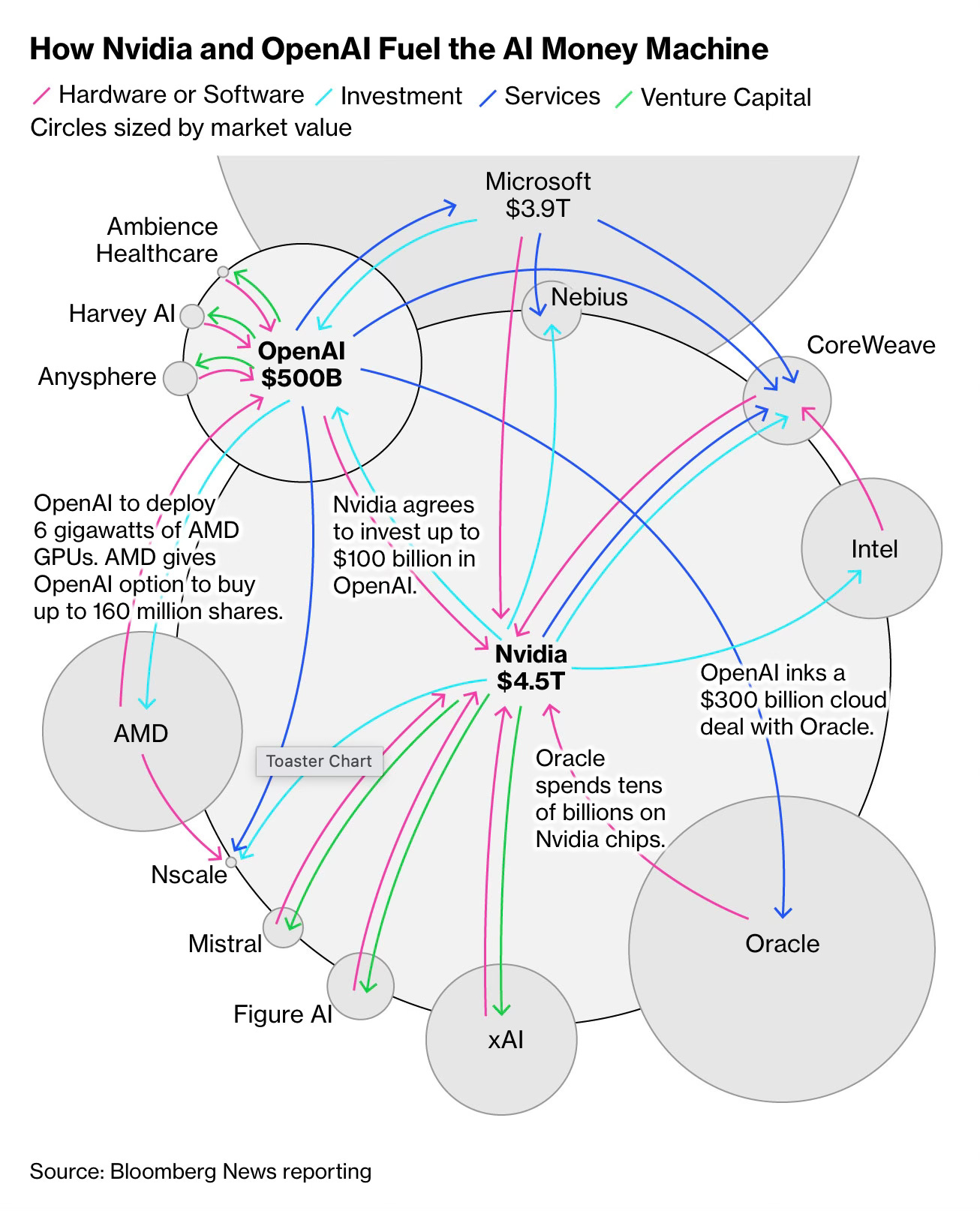The tech boom is starting to look suspicious
Special report
This is a special report and I’m making it free. I spent a lot of time thinking it through over the weekend and wanted to share it. If you find it useful, consider subscribing to this newsletter.I am going to say something that will make people uncomfortable. The earnings being reported by large technology companies right now are not evidence of strength. They are evidence of a sector that has become so large, so interconnected, and so reliant on its own momentum that the numbers deserve far more scepticism than they get.
A lot of the revenue in tech is increasingly generated inside its own walls. OpenAI needs massive computing power, so it’s spending $300 billion with Oracle for cloud services. Oracle needs chips to provide those services, so it spends tens of billions with Nvidia. Nvidia then invests up to $100 billion back into OpenAI. Meanwhile, AMD provides OpenAI with GPUs in exchange for stock options worth 160 million shares. Each company is buying from and investing in the others, creating a closed loop where tech giants finance each other’s growth.
Source: Bloomberg
Nvidia supplies chips to OpenAI directly, while also selling to large cloud providers like Amazon, Google and Microsoft, which reportedly make up around half of Nvidia’s data centre revenue.
These same cloud providers then invest in AI companies that spend billions on cloud services. Oracle borrows to build capacity for OpenAI, then buys Nvidia chips. Nvidia invests back into OpenAI. Microsoft backs AI startups that buy from OpenAI and the cloud providers – I should known because Microsoft offer this same deal to my startup Plotset.com.
The risk is that this resembles a company lending money to its customer to buy its own products. If the same capital is just rotating between related parties, the underlying economic value becomes questionable. The earnings look robust on paper, but scratch beneath the surface and you find the same money flowing in circles between a handful of companies.
Banks did this before the financial crisis
We have been here before. Prior to the great financial crisis in 2008, banks generated huge revenues by trading with each other, packaging loans into securities and selling them to other banks, who then used those securities as collateral for more lending. The interbank market swelled. Everyone recorded profits. The system looked robust because all the participants were strong, creditworthy institutions transacting with each other at scale. It was only when some of the underlying assets failed that contagion spread across the entire market. The complexity made it impossible to understand where the real risks lay. The revenue had been real in accounting terms, but nobody had properly assessed whether the foundations were sound.
Tech is nowhere near that level of fragility. But there is a similar blind spot. AI companies are ploughing hundreds of billions into data centres and energy infrastructure without seriously considering the risk that these investments might not pay off in the long run. If technological improvements make AI dramatically more efficient to run, the massive buildout being financed today could prove unnecessary. The circular flows of capital generate real revenue in the meantime, but nobody is stress testing what happens if the assumptions about future demand turn out to be wrong.
The problem is the structural nature of America’s financial system
This circular financing is enabled and amplified by something deeper. The United States has been pulling in global capital for decades because the dollar is the world’s reserve currency and because American financial markets are the safest place to hide when everything else looks fragile. That constant flow of global money props up valuations and accelerates the circular investment patterns in tech. It gives American firms the freedom to invest far ahead of demand and recycle capital at a scale that other countries simply cannot match. The story we tell about innovation and dominance is not false, but it is incomplete. A structural subsidy has been mistaken for a permanent edge.
The risk is that we have mistaken circular strength for real resilience. People now talk about artificial intelligence as if the outcome is inevitable. Massive data centres. Endless power demand. A world built around gigantic model farms. Trillions in spending have been pencilled in as if the technology has no choice but to unfold in the most expensive possible way. We know from China’s experiences with AI that this doesn’t have to be the case.
The danger is that the big infrastructure race turns out to be a misreading of the trajectory of the technology. Markets are not pricing any of this uncertainty. They are pricing a future that has not happened and may never need to happen.
And then there is the simple fact that every breakthrough eventually becomes a utility. The internet did. Electricity did. Mobile data did. The margins collapsed. The excitement drained away. The value drifted to whoever used the technology best, not whoever built the original machinery.
Microsoft CEO Satya Nadella recently observed that foundational models are becoming increasingly similar and widely available, to the point where “models by themselves are not sufficient” for a lasting competitive edge. Meta released powerful language models openly to researchers and developers at no cost, undercutting rivals’ proprietary advantages. Cloud platforms now offer multiple competing models. Customers can choose and switch providers with relative ease.
AI will go the same way, no matter how breathless today’s forecasts are. Yet the valuations of the biggest tech companies assume not only growth but perpetual exceptionalism. The S&P 500 Information Technology sector now trades on a P/E of about 40, a little more than double its 20 year average near 19. The wider S&P 500 sits on a multiple that is roughly a third above its own long term norm.
How to separate AI winners from losers
The only reason I even bothered to look at recent performance data is because it hints at something people do not want to accept. The spell is weakening. Returns over the past month show technology stocks spreading out dramatically. Some giants like Google and Amazon sit comfortably above zero with double digit gains. Others including Tesla, Meta and Oracle are deep in the red. The idea that all these companies share the same destiny is fading. And that is important!
Source: Plotset.com
Investors are finally asking harder questions. Not every tech giant will come out of this AI cycle in one piece. Google and Amazon have broad revenue streams and huge cloud platforms serving many different customers. Oracle has solid infrastructure too, but its growth story is now heavily tied to OpenAI. If OpenAI falls short of expectations or demand shifts to other models, Oracle will feel it. And OpenAI is not alone at the frontier: Google’s Gemini, Anthropic’s Claude and Meta’s Llama are all real contenders. If any of them can match quality at a meaningfully lower cost, OpenAI’s pricing power shrinks fast.
This is not an argument against technology. When the internet bubble burst in 2000, trillions in market value disappeared. The web still rewired the global economy. Amazon grew stronger. Google built a search empire. Microsoft reinvented itself. The winners were not the loudest story stocks but the firms with durable business models and customers willing to pay.
AI will be the same. The technology is real. The structural shift is happening. But plenty of companies riding today’s AI wave will not make it. Nvidia sells real chips to real data centres, yet some of that demand is fuelled by investor backed experiments that may never turn into lasting revenue. If those projects stall, so does that slice of demand.
The key question is no longer “will AI win” but “who still has resilient, cash paying customers when the circular money dries up”.



